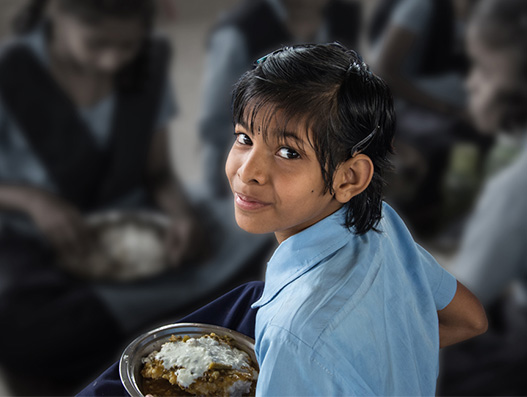
FROM MAGAZINE : The journey to deliver over a million smiles
Text by Surya Kannoth & photos by Meghana Sastry The Akshaya Patra Foundation, along with the Government of India, has been implementing the Mid-Day Meal Scheme, in a continuous effort to bring an end to classroom hunger. Akshaya Patra, with the help of an efficient Food Safety Management System (FSMS), ensures that the quality of […]

Text by Surya Kannoth & photos by Meghana Sastry
The Akshaya Patra Foundation, along with the Government of India, has been implementing the Mid-Day Meal Scheme, in a continuous effort to bring an end to classroom hunger. Akshaya Patra, with the help of an efficient Food Safety Management System (FSMS), ensures that the quality of food delivered from their kitchens is of the highest standards. The entire supply chain management adheres to the norms set by the FSMS to maintain the quality of food. FSMS is implemented in each facet of the supply chain management - right from selection of vendors to the cooking process to the delivery of meals. Supplier Quality Management System (SQMS) is implemented to ensure the quality of the suppliers is at par with the set standards, and only those suppliers are partnered with. These standards set by Akshaya Patra have been the backbone for a strong quality base for the kitchen operations, initiating the society into setting predetermined standards for food quality and nutrition therewith. Today, Akshaya Patra reaches out to 17,49,153 children (1.7 million) in 14,264 schools of the country, with plans to increase that number to hundreds more. It operates 38 kitchens (36 centralised and two decentralised) across 12 states of India, and is taking rapid strides towards the mission to reach 5 million children by 2020.
The term 'Akshaya Patra' literally means an inexhaustible vessel. An object from Hindu mythology, it was a vessel, which held never-failing supply of food. The Akshaya Patra Foundation is an initiative of International Society for Krishna Consciousness (ISKCON) and its vision is “no child in India shall be deprived of education because of hunger”.
The STAT Trade Times visited The Akshaya Patra Foundation’s first centralised kitchen at HK Hill, just outside Bengaluru, which was set up in June 2000, to understand the complexities of the inbound and outbound logistics and meeting the supply chain demands of these mammoth kitchens.

Rice is supplied by the Food Corporation of India (FCI). Before the cooking process, the rice is machine-cleaned and washed thoroughly. In order to ensure all the raw materials are fresh, all the kitchens follow the FIFO (First In First Out) and FEFO (First Expiry First Out) methods while issuing the raw material for production.

Cooking in the centralised units begins early morning. All kitchens follow a scheduled menu. All the centralised kitchens are equipped with cauldrons, trolleys, rice chutes, dal/sambar (lentil/lentil-based vegetable stew) tanks, cutting boards, knives and other similar equipment that are sanitised before usage.

Each rice cauldron has a capacity of at least 500 litres while each sambar cauldron has the capacity to cook 1200 litres to 3000 litres of sambar. All the vessels are of stainless steel 304 food grade material.

Critical Control Points (CCPs) like cooking temperature are checked and recorded at periodic intervals to ensure the right quality of the meal. To ensure food quality is maintained, quality check is done by quality officers in each kitchen.

The cooked food is packed in steam sterilised vessels and labelled appropriately. They are then loaded onto specially designed and customised transport vehicles that are used to deliver food to the schools.


In order to consistently maintain the quality of the meal, feedbacks from schools are taken on a daily basis while delivering the meal. The Quality Officers in the kitchens review the feedback and initiate or trigger appropriate corrective or improvement actions to improve the quality and delivery of food. ‘Do’s and Don’ts’ pamphlets are circulated to all schools on a regular basis for creating awareness on food safety and hygiene while serving the mid-day meals.

